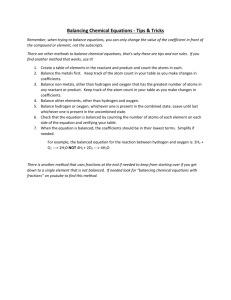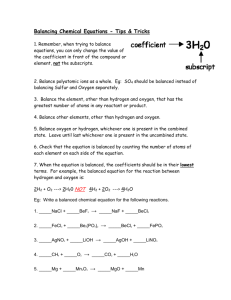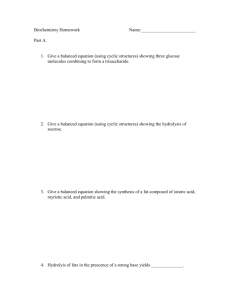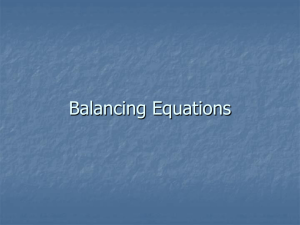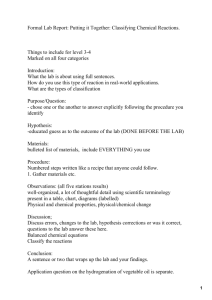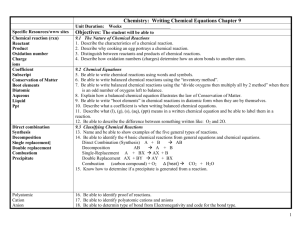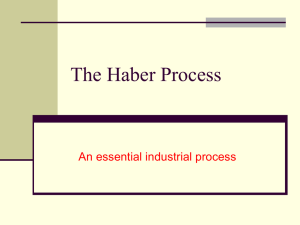Balancing Equations A
advertisement
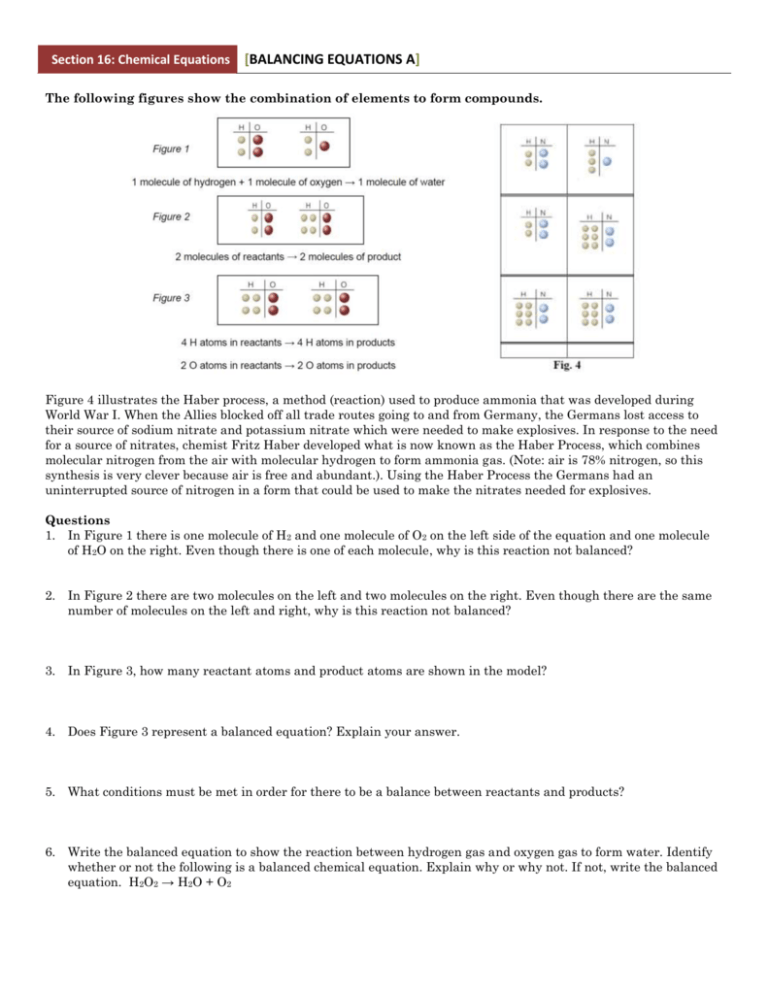
Section 16: Chemical Equations [BALANCING EQUATIONS A] The following figures show the combination of elements to form compounds. Figure 4 illustrates the Haber process, a method (reaction) used to produce ammonia that was developed during World War I. When the Allies blocked off all trade routes going to and from Germany, the Germans lost access to their source of sodium nitrate and potassium nitrate which were needed to make explosives. In response to the need for a source of nitrates, chemist Fritz Haber developed what is now known as the Haber Process, which combines molecular nitrogen from the air with molecular hydrogen to form ammonia gas. (Note: air is 78% nitrogen, so this synthesis is very clever because air is free and abundant.). Using the Haber Process the Germans had an uninterrupted source of nitrogen in a form that could be used to make the nitrates needed for explosives. Questions 1. In Figure 1 there is one molecule of H2 and one molecule of O2 on the left side of the equation and one molecule of H2O on the right. Even though there is one of each molecule, why is this reaction not balanced? 2. In Figure 2 there are two molecules on the left and two molecules on the right. Even though there are the same number of molecules on the left and right, why is this reaction not balanced? 3. In Figure 3, how many reactant atoms and product atoms are shown in the model? 4. Does Figure 3 represent a balanced equation? Explain your answer. 5. What conditions must be met in order for there to be a balance between reactants and products? 6. Write the balanced equation to show the reaction between hydrogen gas and oxygen gas to form water. Identify whether or not the following is a balanced chemical equation. Explain why or why not. If not, write the balanced equation. H2O2 → H2O + O2 Section 16: Chemical Equations [BALANCING EQUATIONS A] 7. If mercury (Hg) and oxygen (O2) were reacted to form mercury (II) oxide (HgO), how many molecules of each reactant would be needed to balance the equation? 8. Describe what is depicted in the first diagram shown at the top of Figure 4. 9. Does the first diagram at the top of Figure 4 represent a balanced chemical equation? Why or why not? Explain your reasoning in terms the type and number of each atom present. 10. Describe what is depicted in the second diagram shown in the middle of Figure 4. 11. Does the second diagram in the middle of Figure 4 represent a balanced chemical equation? Why or why not? Explain your reasoning in terms the number and type of each atom present. 12. Describe what is depicted in the third diagram shown at the bottom of Figure 4. 13. Does the third diagram at the bottom of Figure 4 represent a balanced chemical equation? Why or why not? Explain your reasoning in terms the number and type of each atom present. 14. Write a balanced reaction equation for hydrogen reacting with nitrogen to produce ammonia. 15. Using the smallest whole number coefficients, balance the following reactions. On the right, draw diagrams like those in Figure 4 for Equations a, b, and f. a. __ HgO __ Hg + __O2 b. __ Fe + __ O2 __ Fe2O3 c. __ KClO3 __ KCl + __ O2 d. __ Ca(OH)2 + __ H2SO4 __HOH + __ CaSO4 e. __ Cu + __ AgNO3 __ Cu(NO3)2 + __ Ag f. __ C2H6 + __O2 __ CO2 + __H2O 16. Write the formulas for the components in each reaction and, using the smallest whole number coefficients, balance each equation. a. Zinc metal reacts with hydrochloric acid to produce hydrogen gas and aqueous zinc (II) chloride. b. Solid carbon reacts with oxygen gas to produce carbon dioxide gas. c. Solid sodium chloride is broken down into its elements (remember chlorine is diatomic).
